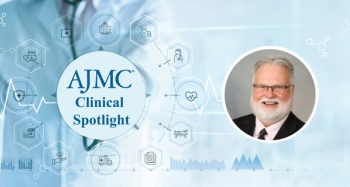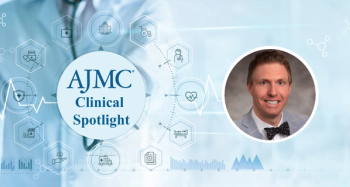
Endometriosis Has Quality-of-Life Impacts, Great Economic Burden, Dr Soyini Hawkins Says
Endometriosis can have a long timeline from onset of symptoms to diagnosis, and in later stages it can affect organs other than the uterus, explained Soyini Hawkins, MD, gynecologist at Fibroid and Pelvic Wellness Center of Georgia.
Diagnosis if endometriosis can take, on average, 7 to 12 years from the time of symptom onset, explained Soyini Hawkins, MD, gynecologist at Fibroid and Pelvic Wellness Center of Georgia. However, there are also patients who are asymptomatic, and their endometriosis is found out as part of another procedure.
In part 1 of an interview with The American Journal of Managed Care® (AJMC®), Hawkins highlights the risk factors for developing endometriosis, the complications and comorbidities of the condition, and how it affects a patient’s quality of life.
Stay tuned for part 2, in which she discusses treatment goals and barriers to optimal treatment for patients with endometriosis.
AJMC®: How common is endometriosis, and what are some possible risk factors that can make women more likely to develop it?
Hawkins: Endometriosis, resources say, has an incidence of about 10%, but in the real world, a lot of clinicians would say that's probably a gross underestimation just because of how difficult it is to get to that diagnosis for many reproductive-age women. Some of the links to increased risk include genetics—it's very much hereditary—but also in the women's lifespan, how much exposure they've had to endogenous and exogenous estrogen. But mainly things like not having children increases your risk, having early onset of menstruation or late menopause [increases risk], because then they've had more lifetime menstrual cycles, more lifetime opportunities for their body to be estrogenized by their ovaries. Those are the common, understood estrogen exposure, things that can increase risk for endometriosis.
But also, things that will actually increase risk of menstrual tissue being able to not get out of the women's body [will increase risk of endometriosis]. So, anything that's going to be an anomaly that is blocking the outflow tract of the uterus, or if they have something like fibroids that can block the outflow tract of the uterus, those women also have increased risk of endometriosis.
Then lastly, diethylstilbestrol exposure in pregnancy, which is not very common—thank the Lord—anymore, but that too increases that risk of endometriosis in women.
AJMC®: Can you describe what does a typical patient journey to diagnosis for endometriosis look like? We know that sometimes this can take a long time, and diagnosis can be delayed or missed in a lot of cases. Do you also see patients that have endometriosis and maybe don't necessarily have any symptoms?
Hawkins: It can take a very long time on average anywhere—if you read the resources—from 7 to 12 years to actually get to a diagnosis. That's from presentation with some of the typical symptoms of endometriosis: painful menstrual cycles, nonmenstrual pain, pain with intercourse, infertility, and things like that. It can be a bit of a torturous course to the diagnosis. A lot of that plays into the fact that endometriosis is a diagnosis of exclusion, meaning that you’ve got to make sure it's nothing else. It's not ovarian cyst, it's not an infection, it's not something anatomical like polyps or fibroids that are contributing to pain with menstrual cycles. Endometriosis, unfortunately, usually is the last to get added to the list of diagnoses, but it actually has a lot of times a very clear clinical picture.
Some of it also is in treatment before diagnosis. A lot of times, typically we treat young women that come in with a complaint of pelvic pain immediately with something like birth control pills, but never really get to the reason for that pain until they're a bit older. So, that delay diagnosis is very true.
You can have patients with endometriosis that are completely asymptomatic. I am a surgeon. I'm a minimally invasive surgeon and so I take a lot of women to the operating room not just for pain, but for sometimes anatomical things such as fibroids, which we noted earlier as a risk factor. I'll get in there and their abdomen will be completely full of endometriosis, and they had no idea, and I had no idea because their symptoms weren't characteristic of that pelvic pain patient. You can have asymptomatic patients. About 1% to 7% of endometriosis patients are asymptomatic.
You can also have patients that present with things like I mentioned before—infertility—and they didn't really have a very clear-cut picture that sounded like endometriosis, but in that infertility work out it's found. They may have something like a genetic track abnormality, which we noted earlier, but 70% of patients that have endometriosis will present with some type of clinical pain picture.
AJMC®: We began to discuss this with infertility, but what are potential complications or comorbidities that can present down the line as a result of endometriosis?
Hawkins: Infertility, I would say is one of the most common thought of sequela of endometriosis in these reproductive-age women. Many of them will find it because they're on that fertility journey.
But if you think about what endometriosis is, it is very much a destructive disease. Endometriosis is when you have implants of endometrial tissue outside of the normal menstrual lining or the uterine lining. It could be anywhere in the body. It can be in the pelvis, most commonly, it can be on the ovaries or tubes. It can be on the bladder surface or in the bladder, on the rectum, or in the bowel. It can go through the diaphragm and be in the thoracic cavity. One of the other comorbidities that some patients with endometriosis have, when it gets to that late stage, it can affect other organs—solid organs. It can affect their bladder and bowel in their thoracic cavity and necessitate really extensive surgery sometimes.
Then it also affects mental health. We can't ever leave that part of it out. A lot of the comorbidities around mental health will have to do with not necessarily a primary depression or anxiety, but a depression or anxiety that's rooted in the fact that these women are chronically in pain.
AJMC®: What does shared decision-making look like in the treatment of endometriosis? How do you approach that with your patients?
Hawkins: My favorite type of medicine. It's the only way we should be treating patients because, at the end of the day, the patient is presenting with a problem and in shared decision-making, the goal is to solve that problem and get them to be whole. That may be again, I keep talking about fertility because it's so huge in this population of concern for women if they're trying to get pregnant or if they're just trying to have some sanity in their day-to-day life and quality of life. Or if they are having symptoms that are presenting with those comorbidities we noted earlier in destruction to other organs, they could have endometriosis wrapped around their ureter that can lead to kidney damage or kidney failure.
Shared decision-making is paying attention to the patient, their symptomatology, what their complaints and concerns are, and their goals. Sometimes that means they don't need just me as a surgeon. Maybe they need their generalist to have them on medication options. Maybe I need to send them to a pelvic physical therapist. I need to involve their reproductive endocrinology specialist to talk to them about what their fertility options and outlook looks like. Maybe I need a pain specialist because I don't want them to be necessarily just on narcotics. Maybe they could be on some alternatives to their pain management—acupuncture.
I think shared decision-making is really meeting the patient where they are in their goals and also expanding ourselves to have a multimodality way of approaching endometriosis, specifically, because there's so many factors that go into it.
AJMC®: How does endometriosis affect a patient’s quality of life? What about missing out on work, school, or other important events? How does it impact activities of daily living?
Hawkins: There's a great economic burden because of endometriosis. Precisely for that reason, a lot of women will miss days of productivity at work. It inhibits their ability to be intimate with their partners, so it affects their home life a lot of times. Sometimes can be limiting because of the day of the month that this is going to occur. A lot of women will report in their initial presentation that “I miss 1 or 2 days of my life every single month.” Meaning “I can't make it to the basketball game or the soccer game on Saturday morning.” Nobody's cooking dinner. If they're a single parent, that can be quite stressful for them.
Even though it's not common that you are going to find an endometriosis patient that can't walk or shower or do common activities of daily living, it impacts their ability to live prosperously and efficiently and be a part of their community, whatever that is: their family, their work, job. I've had women tell me about missed promotions, because they've missed too many days because of their pain. Even though they're excellent at what they do. It absolutely has a great economic impact on work, home life, and some basic activities of daily living.
Every once in a while, you'll see those severe cases where the endometriosis has become so involved neurologically it’s caused problems with things like ambulation.
Newsletter
Stay ahead of policy, cost, and value—subscribe to AJMC for expert insights at the intersection of clinical care and health economics.




























































